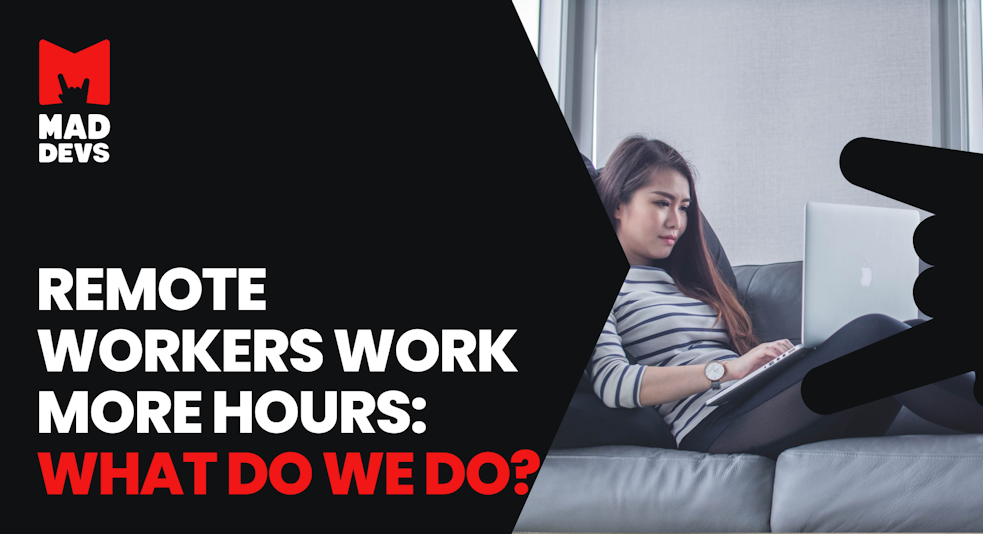The pandemic has changed our life, work, and business. Increasingly, companies are transferring their employees to remote work. The latest study, made by ResearchGate, estimates that by 2025 - 70% of the workforce will work remotely at least five days a month.
When you are an office worker, these changes look like you are being handed the keys to Eden. Wake up a little later, and work in your favorite pajamas and socks without getting out of bed. Sounds good, right?
But this beautiful picture also has a downside. It turned out that remote employees spend significantly more time on work than their in-house counterparts.
In this article, you will read about the benefits and challenges when working remotely and tips to be more productive at home.
What does working remotely mean?
In short, working remotely refers to performing job responsibilities outside of a traditional office environment. Instead of commuting to a physical workplace, individuals work from home, in coffee shops, co-working spaces, or any location with an internet connection. Remote work typically relies on digital communication and collaboration tools to facilitate productivity and maintain connectivity with colleagues. It offers flexible work arrangements, allowing individuals to manage their schedules and balance personal and professional commitments.
The popularity of remote work has steadily increased in recent years. However, the global pandemic in 2020 forced even skeptical companies to embrace telecommuting. Surprisingly, this sudden transition to remote work became a positive outcome during challenging times. It turns out that remote work wasn't as daunting as initially thought.
According to Code Submit research over 4.7 million Americans work remotely at least half the time. Only 16% of companies hire only remote workers, and 44% do not allow remote work.
Globally, according to an Owl Labs study, 16% of companies are fully remote. According to this study, 62% of workers aged 22 to 65 work remotely at least occasionally.
Dessert for the first
In recent years, there have been several research studies; all the results prove one thing—people who work remotely feel happier. Furthermore, according to the 2022 report by Future Forum, employees who can work from home exhibit 4% higher productivity scores compared to those working exclusively in an office. The report further highlights that having schedule flexibility provides even greater advantages. Workers with full schedule flexibility report 29% higher productivity and a 53% improved concentration ability.
The ability to work from home provides people with some benefits. The most significant are:
- Work at your own pace. Most remote workers can schedule their own time and work at a pace that suits them. You can take a break if you are tired or have to take your dog for a walk. If you have back pain, you can do yoga or quick exercises.
- Increased productivity. Without the distractions of a traditional office setting, many people find they can be more focused and accomplish tasks more efficiently.
- Saving time and money. You don't need speed time on travels to the office. Eliminating the daily commute saves time and reduces transportation expenses. And even more, money is spent on lunches and coffee—at home, all this is available in your favorite kitchen. As a result, the savings can be substantial.
- Work-life balance. Remote work provides the opportunity to balance professional and personal commitments better, allowing for more time with family, pursuing hobbies, or engaging in self-care.
- Freedom of geography. Remote work allows individuals to access job opportunities beyond their local area, opening up a wider range of potential positions.
- Environmental impact. With fewer commuters and reduced office space needs, remote work can contribute to a lower carbon footprint and less traffic congestion.
Remote workers spend more hours working
Working from home entails the illusion of greater freedom of action because now you are working on the principle of "organize as you like, just do everything efficiently and on time." So what prevents you, in this case, from turning on YouTube in the background or scrolling down your social media feeds for hours? The danger is exacerbated by the fact that boundaries between work and home are blurring, which reduces the authority of superiors. Remote employees work an average of 1.4 more days per month, or 16.8 more days a year, than their office counterparts. Working from home presents several challenges, including:
- Maintaining work-life balance. Establishing boundaries and avoiding overworking can be challenging without a clear separation between work and personal life. Only 30% of remote workers completely avoid weekend work.
- Distractions and lack of focus. Home environments may have various distractions, such as household chores, family members, or pets, which can hinder productivity and concentration.
- Social isolation. Remote work can lead to feelings of isolation and limited social interaction, especially for individuals who thrive on in-person collaboration and social connections.
- Communication and collaboration difficulties. Remote teams may face effective communication, coordination, and collaboration challenges, particularly when relying on virtual tools and platforms.
- Technical issues. Dependence on technology for remote work can introduce technical challenges, such as internet connectivity problems or software issues, which can disrupt workflow.
- Lack of routine and structure. Without the structure of a traditional office environment, some individuals may struggle with maintaining a consistent routine and self-discipline.
- Less productive. Spending equal time on work as in the office, while being less productive, leads to employees needing to work late nights or weekends to complete tasks.
On the other hand, even if you, on the contrary, plunge into work, just wake up (check your email, start communicating with colleagues, and already think over your tasks for today), you have every chance of facing another danger—professional burnout. According to recent studies, remote workers are experiencing a higher rate of burnout compared to hybrid and in-person workers. An overwhelming 86% of remote workers report feeling burnt out in their current jobs, while 81% of hybrid workers and 70% of in-person workers express the same sentiment. This emphasizes the pressing need to address and mitigate the challenges of remote work burnout.
The point is that when working outside the office, it can be more difficult for employees to distinguish between work and home. Consciousness ceases to perceive the living room as the place where you rest with the whole family and the bedroom as the room in which you sleep and take a rest. All this entails entirely predictable consequences: you lose the ability to relax after hours and start to think about working 24 hours a day. It becomes normal to start watching a chat with colleagues and work on the unfinished report even if you have finished your working day. As a result, work and home are the same for you from now on.
To address the challenge of spending excessive hours on remote work, consider implementing strategies to optimize productivity and achieve a better work-life balance. Set clear boundaries and establish a designated workspace, prioritize tasks effectively, take regular breaks to avoid burnout, and utilize technology tools to streamline workflows. Let’s see what tips you can implement to reduce the hours spent on remote work while maintaining productivity and well-being.
Tips to be more productive at home
Issues mentioned above and others must be addressed when working remotely, especially from home. Here are some recommendations for enhancing productivity and achieving a fulfilling remote work experience.
- Schedule
Set precise times when you must start your workday and when you end. For more effect, you can add a ritual that replaces the way home from the office. For example, take a shower to relieve all fatigue and "close" the working day. - Tools
Since remote work is connected with your devices, you can customize them for your benefit. Use various tools to help you be more productive while you work, and turn off notifications while you relax. You don't have to be online 24/7 if you work from home. - Rest
Let go of the thought that you will miss an important message if you go to the refrigerator. In the office, you can safely leave for a drink of coffee, go out to breathe, talk with colleagues. Why should the rules of the game be changed to work remotely? Be sure to take breaks of 10-15 minutes. This way, you won't burn out, and you won't have to spend extra time on tasks. And most importantly, weekends are only for your own time. It is possible to work on these two days only if the fate of humanity depends on it. If this is not the case, everything else may wait until Monday. - Set goals
Setting goals while working from home is crucial for productivity. Specific and measurable goals should be broken down into manageable tasks with assigned deadlines. Prioritizing and writing down goals helps maintain focus and accountability. Tracking progress and adjusting goals periodically ensures alignment with objectives. Staying motivated and seeking support enhances goal achievement. By following these tips, remote workers can optimize their productivity and effectively manage their work-from-home environment. - Break work into smaller tasks
Breaking work into smaller tasks is essential for increased focus, motivation, prioritization, stress reduction, and effective time management. By breaking down complex tasks into manageable chunks, you can maintain better concentration, experience a sense of progress, prioritize effectively, reduce stress, and allocate time wisely. This approach enhances productivity and success by providing a structured framework for completing work efficiently and achieving goals within the desired timeframe. - Minimize distractions
Minimizing distractions while working from home is essential for maintaining focus, productivity, and meeting deadlines. You can create a conducive work environment by reducing interruptions from social media, personal devices, household chores, and other distractions. This helps you stay engaged, concentrate on tasks, and complete them efficiently. Minimizing distractions promotes better time management, enhances concentration, and improves overall work quality. Ultimately, it allows you to make the most of your remote work setup and achieve optimal productivity. - Set up a workspace
Creating a dedicated workspace while working remotely is essential for work-life balance, focus, productivity, and maintaining a professional image. It establishes boundaries, minimizes distractions, and promotes organization, resulting in a more fulfilling remote work experience. - Leave home
Take breaks from your home office by stepping outside for fresh air and natural light. It's beneficial for both remote and in-person workers to leave the workspace and move their bodies throughout the day. Consider visiting cafes, libraries, or co-working spaces if possible. However, the key is to prioritize leaving your home, even if it's just for a walk or spending time outdoors. - Socialize with colleagues
Remote work can bring feelings of loneliness and isolation, particularly for extroverts. Companies can address this by fostering social connections through team messaging apps and organizing meetups. It's important to find the right level of interpersonal interaction that makes you feel connected. Even if you're introverted, consider participating in online activities to stay familiar with socializing options. However, be mindful of potential distractions caused by team messaging apps.
What are the best tools and technologies for remote collaboration?
Regarding remote collaboration, utilizing the right tools and technologies is crucial.
- Communication tools. Popular options include tools like Slack and Zoom for real-time interaction.
- Project management tools. Consider platforms like Jira and Asana for task organization.
- File-sharing/storage platforms. Take note of tools such as Google Drive and Dropbox.
- Online document collaboration. Tools like Google Docs and Microsoft Office 365 allow multiple users to work on files simultaneously.
- Virtual whiteboarding tools. Use tools like Miro and MURAL to aid in collaborative brainstorming while on task.
- Time-tracking apps. You may use tools like Toggl that will help you to monitor your productivity.
- Remote access and VPN software. Ensure secure connections by using VPN software like NordVPN or Tunnel Bear.
- Online learning platforms. Take a look at platforms like Udemy and Coursera provide opportunities for skill development.
The choice of tools should align with the team's specific needs and collaboration requirements.
To wrap up
Remote work is our new reality. Despite the significant benefits, ensuring that it does not intertwine and consume your entire life is vital. Work should remain work, no matter where it takes place—office or home.
In order to make it convenient for you to track your own progress working remotely or not, you can use our tool—Enji.ai. Enji is a useful tool that provides a comprehensive project overview using all the data it collects, and it is always up-to-date. You can visit the official website or contact us for more information.
FAQ
How can I stay productive and focused while working from home?
How can I overcome feelings of isolation and maintain motivation while working remotely?
How can I create an ergonomic and comfortable home office setup?

Internal and External Stakeholders Types, Differences,...
Internal and External Stakeholders...
Internal and External Stakeholders Types, Differences, and Roles
World politics and economics have bound most countries together and made companies more dependent on each other than ever before. Resource and...









